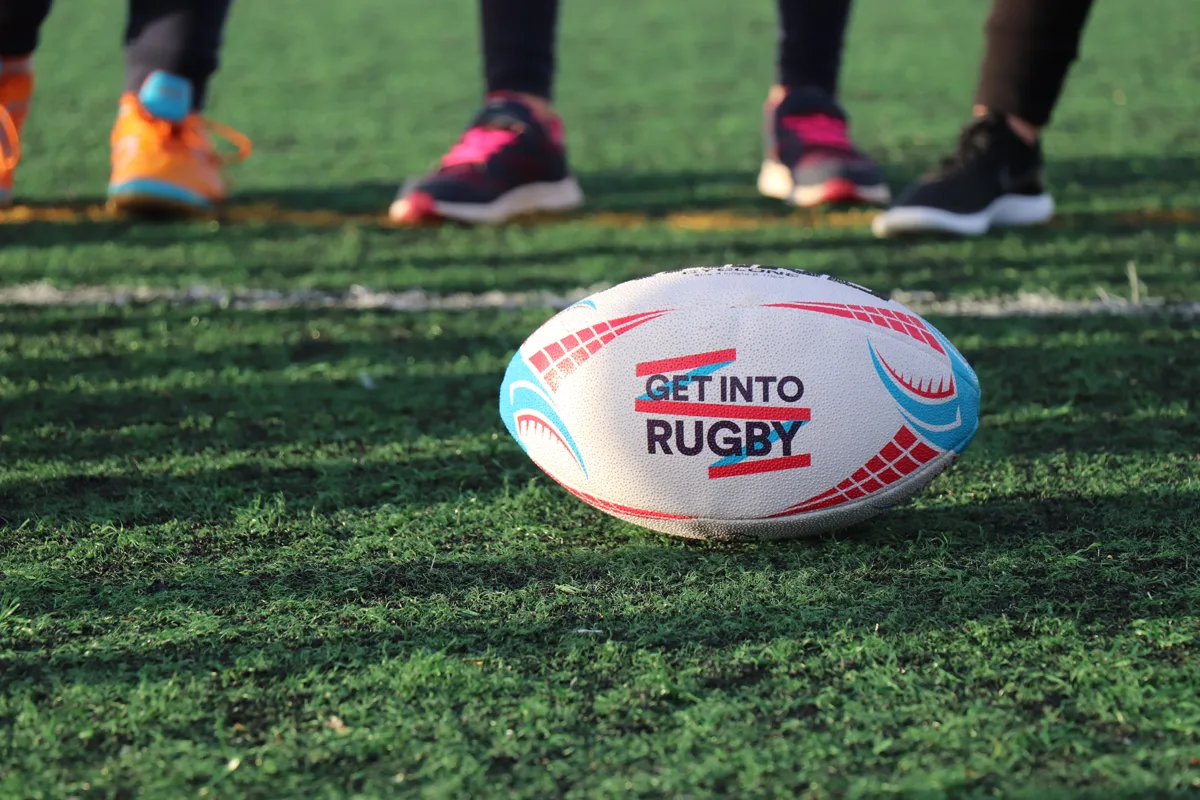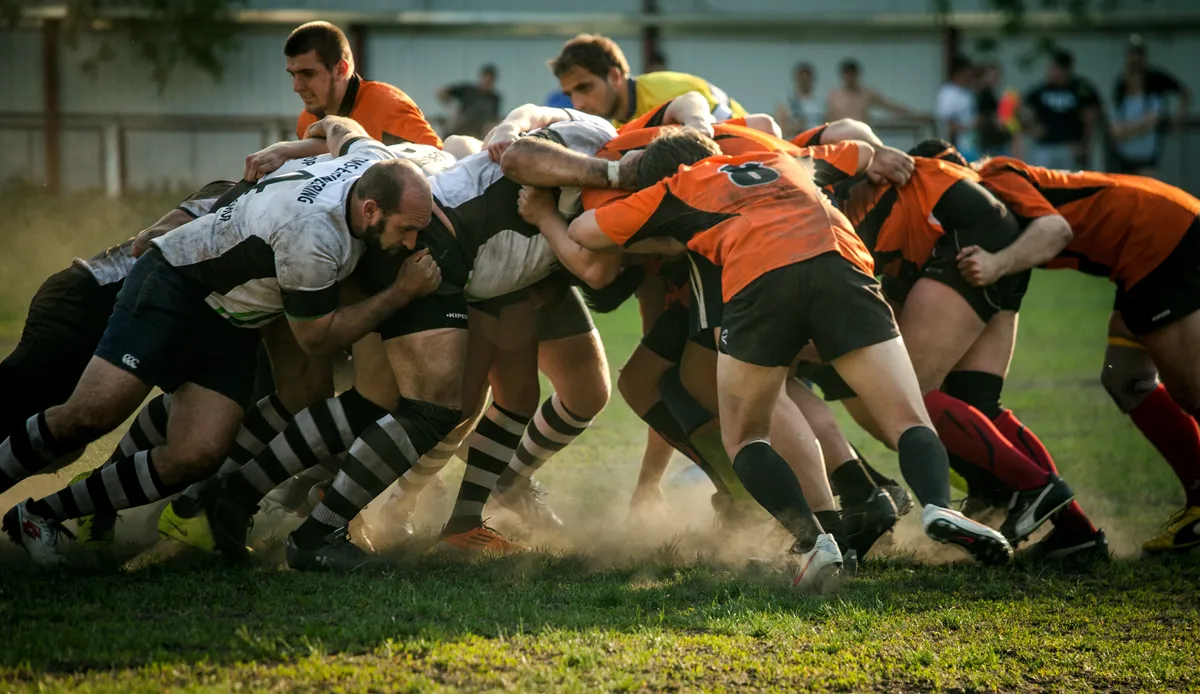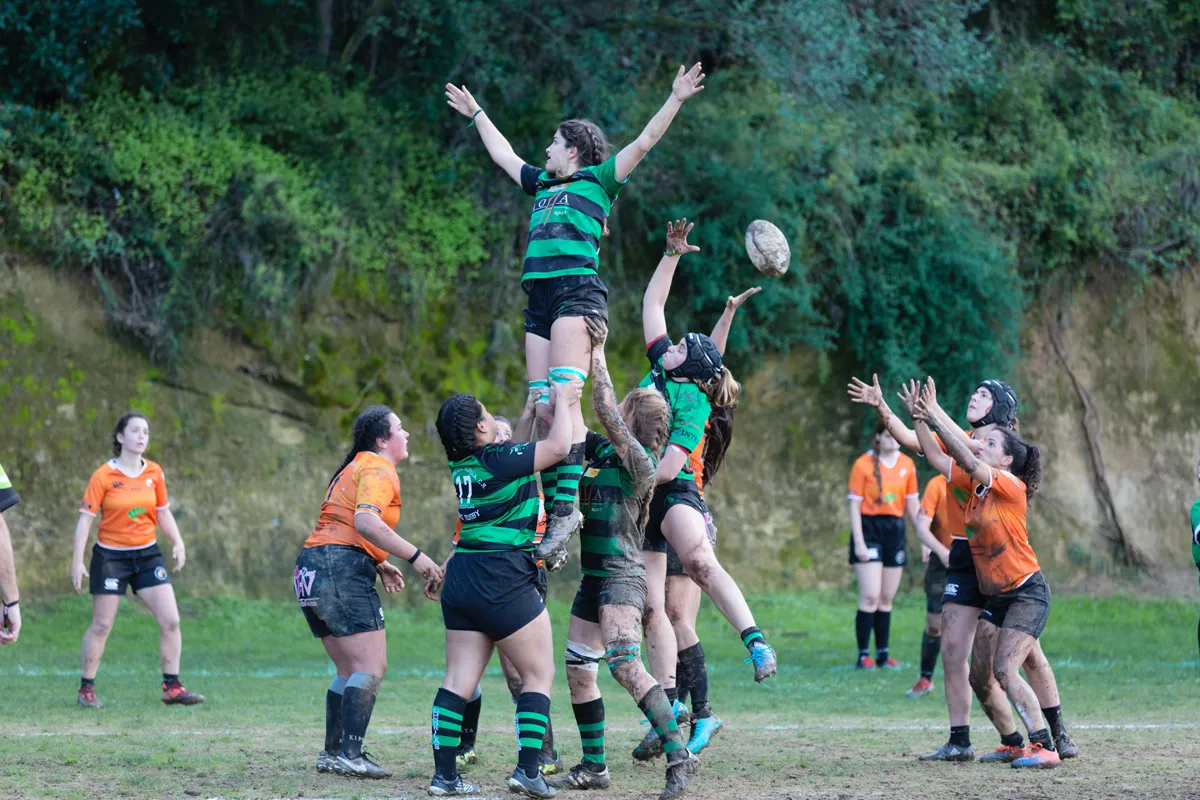Rugby, at first glance, seems intimidating to learn as an adult. However, most adult rugby clubs are incredibly welcoming to beginners. So, if you want to learn how to play rugby and where to play it, Adults Play Sports is here to help with our comprehensive guide.
We’ll explain the sport’s rules, how to prepare to play rugby, and what gear you’ll need to be game-ready. We even have a searchable directory of sports leagues to help you find a suitable adult rugby club near you.
Rugby is a solid choice for adult athletes who want a sport with physicality and who also crave the camaraderie of a team. If you’re curious about learning to play rugby, many rugby clubs invite first-timers for a practice session to get a feel for the sport. It’s a great way to dip your toe in the adult rugby pool.
Table of Contents

Photo by Edgar Pimenta on Unsplash
A Brief History of Rugby
Rugby’s origins date back to the nineteenth century and are steeped in a bit of mystery. A popular legend says the sport began in England at Rugby School in 1823. Student athlete William Webb Ellis was playing soccer (or football for the rest of the world), picked up the ball mid-game, and ran downfield to the opponent’s goal.
By the way, it would be another 76 years before American football, which combines rugby and soccer, was invented.
Rugby is a sport played around the globe. In North America, there are approximately 250,000 adults who play rugby, and its popularity continues to grow.
Understanding Rugby: The Basics
Rugby, often perceived as a complex sport, is grounded in straightforward principles that make it accessible to beginners. Understanding these basics is important, but like most sports, rugby rules have nuances.
The quick gist of the rugby game: players attempt to run the ball down the field while passing and catching the ball, evading tackles, and trying to create scoring opportunities. Get updates and exclusive special offers. No spam–just valuable content. join the aps squad
Rugby Variants
There are two typical rugby variants: rugby union and rugby league. Each has distinct rules and gameplay styles. However, the main objective is the same–to score the most goals against your opponent and to keep your opponent from scoring on you.
Rugby Union: The game is split into two 40-minute halves, with 15 players on each team. There are several ways to score points in union play, which include:
- Try (5 points): A player scores by placing the ball down in the opponent’s goal area, known as the ‘in-goal area.’
- Conversion Kick (2 points): After scoring a try, the team gets an opportunity to kick the ball between the goalposts for extra points (similar to a field goal in football).
- Drop Goal (3 points): During general play, a player may kick the ball between the goalposts for points.
- Penalty Kick (3 points): Penalty kicks are awarded when there are major infringements against an opponent. The opponent has a chance to kick the ball between the goalposts at the site of the infraction.
Common elements of rugby union include:
- Scrums: A scrum formation restarts play after certain stoppages, such as a minor infringement or when the ball has become unplayable. It involves the forwards from both teams coming together in a tightly bound formation to contest for possession of the ball.
- Lineouts: A lineout is a set piece where the ball is thrown back into play after it has gone out of bounds (across the sideline). It restarts play after a stoppage. Lineouts typically occur after the ball has been kicked or carried out of bounds.
- Rucks: A ruck is a phase of play that occurs when the ball is on the ground, and one or more players from each team come together over it, binding and driving to contest possession. Rucks are a fundamental part of rugby and typically happen after a player carrying the ball is tackled and brought to the ground.

Photo by Olga Guryanova on Unsplash
Rugby League: There are 13 players per team in this rugby variant, and the game length is the same as rugby union–80 minutes. There is the same objective to score points as in union play, but the point structure differs slightly.
Here’s how scoring differs, along with other elements of rugby league:
- Try (4 points)
- Conversion Kick (2 points)
- Drop Goal (1 point)
- Penalty Kick (2 points)
Key elements of rugby league include:
- Tackles: Unlike rugby union, rugby league has a ‘six-tackle rule.’ After six tackles, the team must surrender the ball to their opponent.
- Play-the-Ball: This is rugby league’s version of the ruck. After a tackle, play restarts when the tackled player rolls the ball backward to a teammate with their foot.
- Scrums: Scrums in rugby league occur less often than in rugby union and involve fewer players.
Rugby league is known for its fast pace and fewer stoppages than rugby union. In North America, rugby union is far more common among recreational rugby leagues.
Understanding Rugby Positions
Besides the different rugby variants, it’s helpful for adult rugby beginners to understand positions. Every position has its unique role that contributes to the game. Once you grasp positions, you’ll better understand which might suit you based on your size, strength, speed, and other factors.
There are two overarching rugby positions: forwards and backs.
Forwards
Forwards are typically involved in the physical aspects of the game, such as scrums, lineouts, rucks, and mauls. They also play a crucial role in ball-carrying, supporting ball carriers, and making tackles. Creating space for the backs is another role of forwards.
1. Props: Props are typically strong, powerful players. They need to hold their ground in scrums and contribute to pushing the opposing team off the ball. Prop forwards are usually well-built, with strong upper bodies.
2. Hookers: Hookers are the “engine room” of the scrum. They need strength and accuracy to throw the ball in lineouts. They are usually of average height and build, with good upper body strength.
3. Locks (Second Rows): Locks are often the tallest players on the team because they need to jump high in lineouts to secure possession. Height, good jumping ability, and strength are typical attributes for locks.
4. Flankers: Flankers are versatile players who are typically quick and agile. They are involved in various aspects of the game, including tackling, rucking, and carrying the ball. They need speed, agility, and endurance.
5. Number Eight: Number eights are positioned at the back of the scrum and often pick up the ball to initiate attacks. They need strength, speed, and ball-handling skills. They are typically powerful and agile.
Backs
1. Scrum-Halves (Halfbacks): Scrum-halves are typically shorter and agile. They need quick passing skills and excellent decision-making abilities. Their agility allows them to dart through gaps and provide fast service to the fly-half.
2. Fly-Halves (Out-Halves): Fly-halves are often playmakers, so they need excellent passing and kicking skills. They must be calm under pressure and have good decision-making abilities. They are usually agile and have strong kicking legs.
3. Centers: Centers perform best when they combine speed, power, and agility. Inside centers (number 12) are often strong runners who can break tackles, while outside centers (number 13) need speed to exploit gaps in the opposition’s defense.
4. Wings: Wings are typically the fastest players on the team. Speed, agility, and good finishing abilities help to score tries. They also need to be strong tacklers when defending.
5. Fullbacks: Fullbacks need to be excellent under the high ball, as they often catch kicks from the opposition. They should have good kicking skills, be fast runners, and be able to counter-attack effectively.
It’s important to note that rugby is a team sport, and players work together regardless of their positions. Versatility is a common trait of rugby players who often adapt to multiple positions.
As a beginner to rugby, try out different positions, and you’ll immediately recognize where your natural strengths and preferences lie. If you’re larger and stronger, a forward position might best suit you. If you’re quicker and more agile, a back position could be a better fit.
As you progress, you’ll better understand your role and how it fits into the team’s overall strategy.
Learning And Developing Rugby Skills
For adults starting rugby, mastering the basic skills is a cornerstone of enjoying and excelling at the game. You’ll need to focus on a few critical skills to play rugby.
Passing and Catching: The backbone of rugby is the ability to accurately pass and catch the ball. Start with basic two-handed passes and progress to one-handed and offload passes. Practice with a partner or against a wall to improve accuracy and hand-eye coordination.
Tackling: Tackling is a critical skill in rugby to stop opponents. Learn the correct technique to tackle safely and effectively. You’ll need to practice proper body positioning, timing, and using your arms and shoulders correctly.
Kicking: Kicking in rugby is used for scoring, gaining territory, and restarting play. Practice different kicks, such as the punt, drop kick, and grubber. Focus on your technique, including foot positioning and ball contact.
Running with the Ball: Being comfortable running with the ball is vital. Work on your running technique while securely holding the ball. Rugby runs typically aren’t a straight line, so practice lateral running and changing speed.
Scrummaging: For forwards, understanding the dynamics of scrummaging is essential. This skill requires strength, technique, and coordination with fellow forwards. Start with non-contact scrum practices to get the positioning and binding right.
Lineouts and Rucks: Learn the rules and techniques for participating in lineouts (for forwards) and rucks (for all players). These skills require good timing and an understanding of the rules of the game.
For adult beginners, be patient with yourself. Rugby skills can be complex and require time to master. If the club you’re interested in holds training sessions, make sure to attend, as this will help build your skills. Ask the coach or other players for feedback.
Remember, every player was once a beginner, and with perseverance, there’s no doubt you will improve–even starting as an adult.
Get Fit For Rugby


Photo by Philippa Rose-Tite
Rugby can be a physically demanding sport. For adult beginners, building rugby-specific fitness can make games more enjoyable while minimizing the risk of injury. Here’s how to develop the necessary fitness for rugby:
High-Intensity Interval Training (HIIT): Rugby is a game of short bursts of high-intensity activity. HIIT workouts, which alternate between intense bursts of activity and fixed periods of less intense activity, are great for simulating the physical demands of a rugby match.
Strength Training: Rugby players need a good base of strength. Focus on compound movements such as squats, deadlifts, and bench presses. These exercises work multiple muscle groups and are effective in building functional strength. Bodyweight exercises like push-ups and pull-ups will build upper body strength for better passing and catching.
Agility and Speed: Being able to change direction quickly and move swiftly is crucial in rugby. Incorporate agility drills like ladder drills, cone drills, and shuttle runs into your training. These improve your ability to move swiftly and efficiently on the field.
Plyometric Exercises: These exercises help develop explosive power, an essential component of rugby. Incorporate jump squats and box jumps in your training to improve power.
Flexibility and Mobility: Good flexibility can improve your performance and decrease the risk of injury. Incorporate stretching into your daily routine, focusing on the major muscle groups used in rugby.
Nutrition: The right diet is paramount for the best performance in rugby, as in most sports. Read a sports dietitian’s nutrition advice on how to properly fuel your body for playing sports.
And last but not least
Rest and Recovery: Don’t underestimate the importance of rest and recovery, especially as a beginner to rugby. Your muscles need time to repair and strengthen, so ensure you’re getting adequate rest and not overtraining.
Finding the Right Rugby Club
If you’re an adult venturing into rugby for the first time, finding a club that suits your playing style, ability, and personality are factors to consider. While most rugby clubs maintain separate male and female teams, some offer mixed and co-ed gender teams.
A suitable club can significantly enhance your rugby playing experience and create bonds off the field, too.
Some things to consider when choosing a rugby club include:
Is the club welcoming to beginners? If you’ve never played rugby, you don’t want to jump straight to an ultra-competitive club–nor would they likely have you. So look for clubs that are open to newbies.
Does the club offer coaching or training? Some clubs might have coaches, while players simply manage themselves in other clubs. Coaches are less prevalent in casual adult rugby clubs, but that doesn’t mean you won’t get playing advice from teammates. It will just be less formal.
What is the club’s culture and environment? Some clubs blend socializing and gameplay more than others. Many clubs celebrate the ‘third half’ after games and socialize with opponents over drinks and food. Others are actively involved in community service objectives.
Are you part of the LGBTQ+ community? If you prefer playing with a club that puts inclusivity front and center, you’ll find many adult rugby clubs that are part of IGR (International Gay Rugby). The IGR is an organization that supports LGBTQ+ rugby clubs globally.
Does the club offer adaptive rugby? If you have physical disabilities that prohibit you from playing traditional rugby, some leagues offer wheelchair rugby. Again, check out our directory for leagues to find adaptive sports near you.


Non-Contact Rugby Is Great For Adult Beginners
If you’re hesitant about the physical aspects of rugby, especially starting the sport as an adult, consider playing a non-contact variant. Touch or tag rugby are great ways to ease into the sport to see if you love it. If you do, you can progress to contact play if that’s your goal.
Non-contact rugby allows you to learn skills like passing, catching, and movement without the pressure of potentially dangerous physical contact. It makes for an ideal environment to understand the flow and rules of the game in a more relaxed setting.
Since tackling is omitted from non-contact rugby, you can focus more on improving speed, agility, and evasive maneuvers, which will help when and if you transition to contact rugby.
Recommended Rugby Gear
The right rugby gear is imperative for performance, safety, and comfort. There are some non-negotiables when it comes to rugby equipment, and then there are some optional pieces of kit.
Essential Rugby Gear
Rugby Boots: Rugby boots have studs that help grip the ground to provide stability during play. Choose boots that are comfortable and suited to playing on soft or hard ground.
Mouthguard: While not required by every league, wearing a mouthguard is advisable. You’ll want to protect your teeth and gums during tackles and scrums. Opt for a well-fitting, quality mouthguard to ensure maximum protection.
Rugby Shirt and Shorts: During sanctioned rugby matches, you’ll don the uniform mandated by your club.
Optional Rugby Gear
Protective Clothing: While rugby doesn’t involve as much protective gear as American football, there are some options for additional protection. Padded shirts or shorts add extra cushion for shoulders and thighs.
Scrum Cap: Some players prefer wearing a scrum cap, which is a soft padded helmet to protect the head during scrums and tackles.
Shin Pads: Like the scrum cap, shin pads offer additional protection but are not mandatory. As a beginner adult rugby player, you might want to opt for them as you get used to the physical nature of the game.
Get Out There And Play
Now that you’ve learned the basics and understand that rugby is a welcoming sport for adults, even beginners, there’s no excuse to not give it a try.








